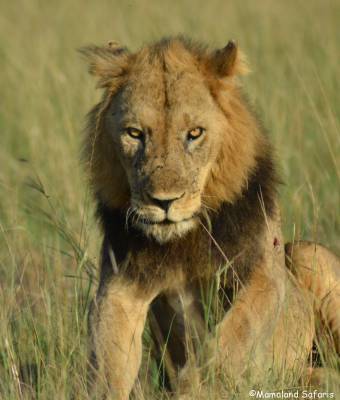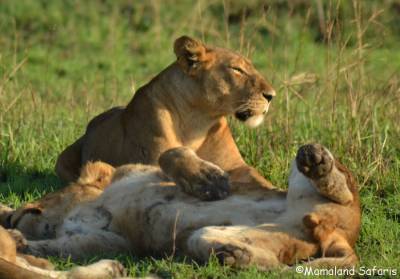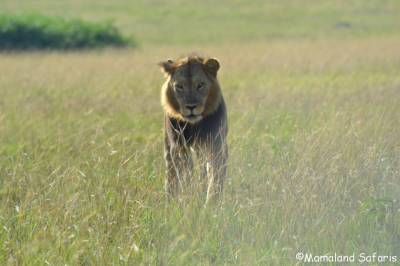See lions close up during a lion research safari in Queen Elizabeth national park and learn more about them. With our tours there is a chance to visit and come close to these great cats. During our July visit with a conservation and naturalist couple from the USA, we had yet a superb sighting, and a lot to learn from the Lions of Kasenyi (a part of Queen Elizabeth national park). We learned about the successful research to save the Lions in Uganda after the threatening epidemic that was first erasing the Great Cats population in Serengeti, the killer Disease known as Canine distemper, a viral disease. In 1996 the project to save the population in Uganda started.
We drove around the circuits with a lot of other big mammals on the plains with the dominating Euphorbia candelabra well spaces trees that give the northern sector of the park a great setting of the land scape with the morning Golden light creating a real charm of the African Protected area. We were able to locate the mobile Pride of the Kob mating ground area with our research assistant. The Savannah here is dotted with shrubs and thickets with the park laying on the floor of the western rift valley this makes it quite wide to cover as many broader thick vegetation. Ones referred to as Bushes by the tourist and guides but these to me are “Lion apartment blocks” or houses for these Great cats. By the time the project started it was about 130 lions in the conservation area. The research assistant noted painfully that the number today is about 85 combining Ishasha, Kyambura and Kasenyi – Mweya peninsular sectors of Queen Elizabeth national park.
With Queen Elizabeth national park classified as a Biosphere reserve, meaning that specific communities of people have been permitted to live within the park. The park accommodates over 5 big communities co-existing in one conservation area for generations progressing from Fishing, basic subsistence farming to small enterprises. The Cats and other Predators of Queen Elizabeth national park, which are our classical safari attraction subjects and of-course for conservation importance are easily targeted once conflicts with human neighbors surface to the slightest notice. It wasn`t unusual to find Lion carcasses, hyenas, white backed vultures and Ruppell`s Vultures with the impressive Lappet vultures succumbing to retaliation lethal poisons infused or embedded in domestic bovines carcasses.
With the cubs population put in check and almost half of the cubs not reaching there 2nd year, its noticed that Hyenas, Pythons and Leopards the competitors on the same pitch for prey and survival for there next generation genes. Bovines like the Cape and forest Buffaloes too stand high in finishing off our beloved Lions. With over 40 % of the Panthera leo population decline in the last 20years, its eminent that with this shocking decline the RED BIG DOT on the IUCN list, The only Social cats in the world are Branded VULNERABLE! With our experiential tourism, like the safari with a lion research assistant, gelling with re-thinking the community into awareness and participation for sustainable tourism as we conserve for generations.
Monitoring a pride means to follow them in their homes of which some prides can be highly mobile and with the style of resting this Felines display after feeding, its possible that they can stay hidden in thick bushes, rug terrains, rocky kopjes which without a radio transmitter its hard to achieve the samples, get vaccines or even locate dead Lions from sickness, or retaliation from humans sharing the same eco- system. A collar could cost between $500-$3000 or even more as some help to be located and data taken with some sending alerts, emails to the researchers at the base if the animals have been immobile for hours making field workers more alert! The drugs to put the subject to sleep is expensive too plus a professional operation to act fast and careful during the radio collar installation which could involve drama as simple molestation, casting objects to the docile King of the jungle as to confirm if the veterinary savannah table doesn`t end up as a restaurant!
Last July we monitored 3 groups far apart, including the 3 male Lions featured in the Video on our home page Code named the Lion Bridge, that left Ishasha tree Climbing Lion Sector, took a nomadic approach and covered over 70 Kms to their new settlement now. We also got to Monitor the female lions Lina and Bridget a senior hunter in the group with their 6 cubs.
As research tourist, visitor for our experiential Lion tourism, we get to help the owners of the affected Livestock, casualties to the Felines a consolation support as we bond broken ties with wildlife with the communities at large. With trophy hunting taking a bizarre new twist in Africa, the African lion will soon sooner than the next COMET disappear like other friendly nice members of our Planet. Is the Rationale that trophy hunting sponsors conservation just?
Act now!
The lions in Queen Elizabeth national park are being helped by the research project. Conservation for generations will ensure the future of Uganda’s lions.







